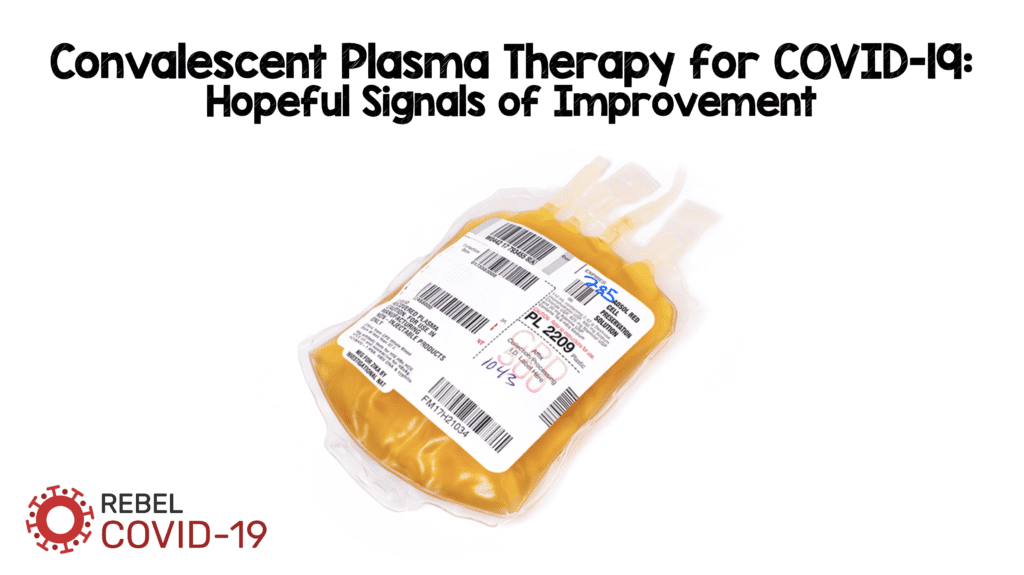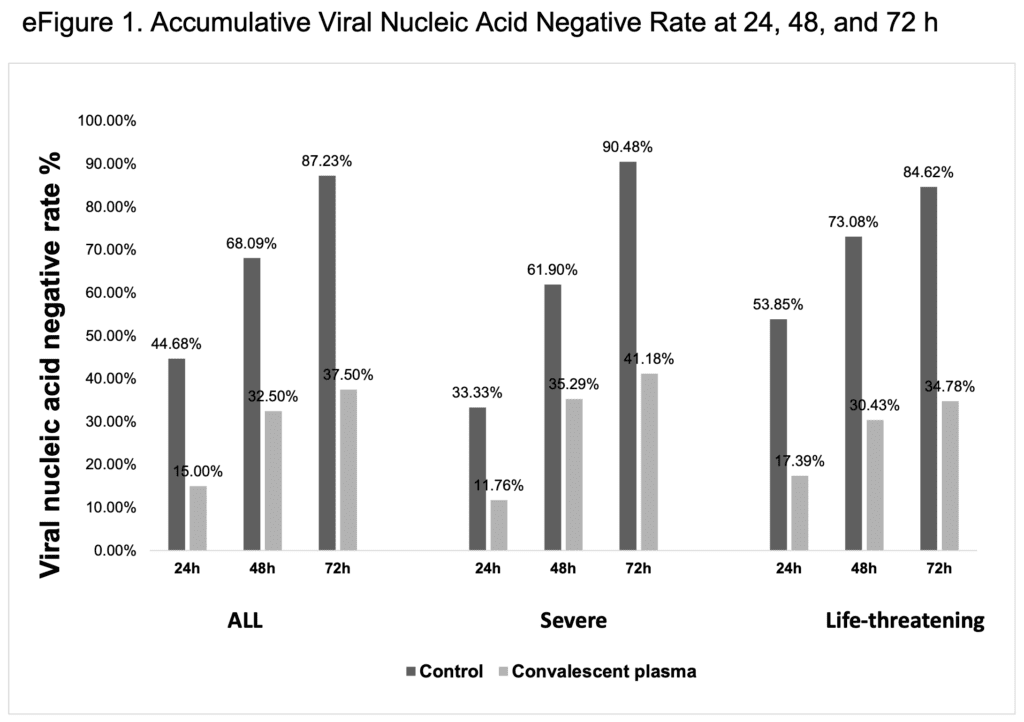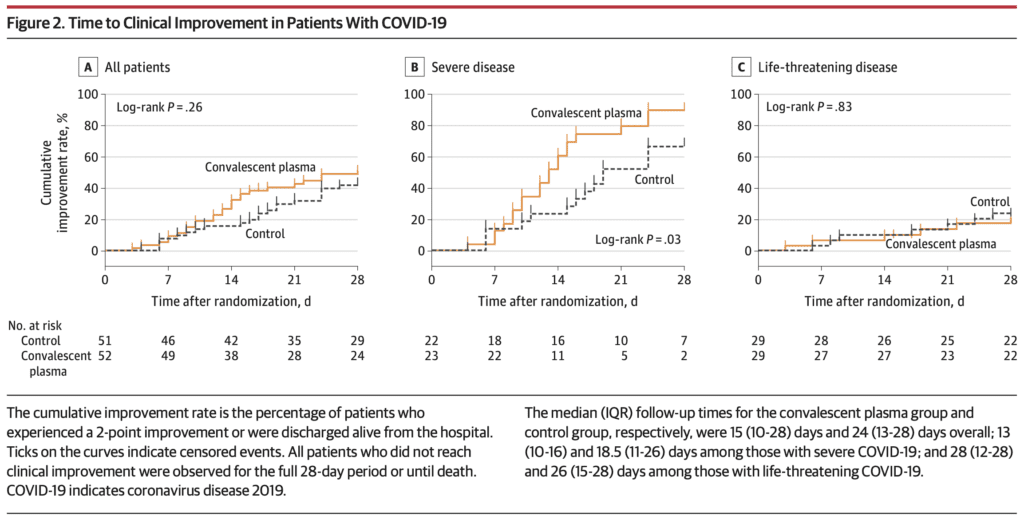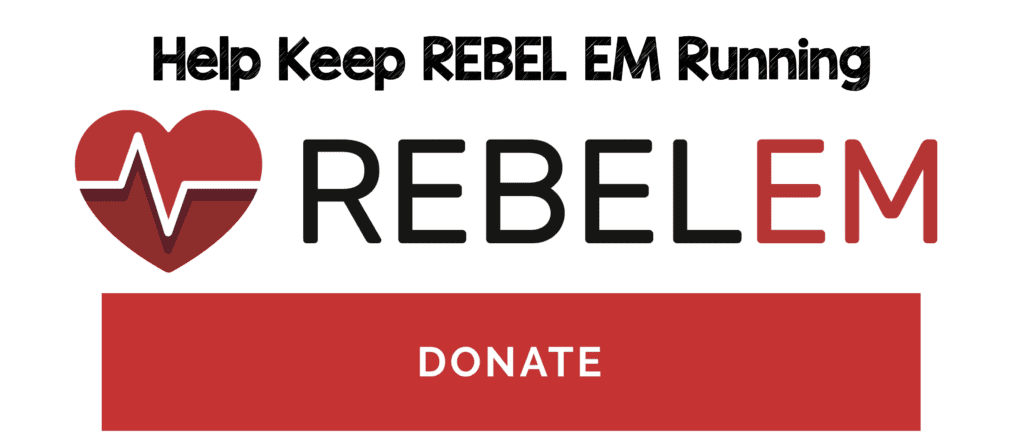
 Background: Convalescent plasma therapy is not a new or novel therapeutic option. It involves taking the plasma from patients who have recovered from an illness and using it to treat patients who currently have the same illness. This approach has been evaluated in the treatment of SARS, MERS, and ebola but, none of the studies in these disease showed definitive results. Thus far, the amount of evidence on convalescent plasma therapy in COVID-19 is also limited. There was a case series of 5 patients [2] and a systematic review of 5 trials with 27 patients [3]. Neither study was earth-shattering. However, both showed improved weaning from mechanical ventilation and no adverse events in the convalescent plasma group. With a total of 32 patients, we should not put any weight in either of these trials. We now have our first randomized clinical trial on convalescent plasma therapy.
Background: Convalescent plasma therapy is not a new or novel therapeutic option. It involves taking the plasma from patients who have recovered from an illness and using it to treat patients who currently have the same illness. This approach has been evaluated in the treatment of SARS, MERS, and ebola but, none of the studies in these disease showed definitive results. Thus far, the amount of evidence on convalescent plasma therapy in COVID-19 is also limited. There was a case series of 5 patients [2] and a systematic review of 5 trials with 27 patients [3]. Neither study was earth-shattering. However, both showed improved weaning from mechanical ventilation and no adverse events in the convalescent plasma group. With a total of 32 patients, we should not put any weight in either of these trials. We now have our first randomized clinical trial on convalescent plasma therapy.
Paper: Li L et al. Effect of Convalescent Plasma Therapy on Time to Clinical Improvement in Patients With Severe and Life-Threatening COVID-19: A Randomized Clinical Trial. JAMA 2020. PMID: 32492084
Clinical Question: Does convalescent plasma therapy added to standard treatment vs standard treatment alone reduce the time to clinical improvement within 28 days in patients with severe and life-threatening COVID-19?
What They Did:
- Open-label, multicenter, randomized clinical trial
- 7 medical centers in Wuhan, China
- Severe COVID-19 = respiratory distress and/or hypoxemia (≥30 BPM in resting state and/or O2 sat ≤93% on RA and/or P/F ratio ≤300)
- Life-Threatening COVID-19 = shock, organ failure, or requiring mechanical ventilation
- Patients randomized to:
- Convalescent plasma + standard treatment (CP+ST)
- Standard treatment alone (ST)
- Looking for a projected 8-day faster improvement
- Convalescent Plasma Logistics: To ensure therapeutic potency of convalescent plasma, only plasma units with an S-RBD-specific IgG titer of at least 1:640 was used for this study. The transfusion dose was 4 to 13 mL/kg of recipient body weight. No premedication was given before convalescent plasma transfusion. The median plasma infusion volume was 200mL and 96% received a single dose of plasma infusion
- Standard Treatment = symptomatic control and supportive care (i.e. antiviral medication, antibacterial medications, steroids, human immunoglobulin, Chinese herbal medicines, etc as dictated by Chinese policy.)
Outcomes:
-
Primary: Time to clinical improvement within 28 days (i.e. discharged alive or reduction of 2 points on a 5-point disease severity scale)
- 1 = discharge
- 2 = hospitalization + no supplemental O2
- 3 = hospitalization + supplemental O2 (not HFNC or NIV)
- 4 = hospitalization + HFNC or NIV
- 5 = hospitalization + ECMO or IMV
- 6 = death
-
Secondary:
- 28-day mortality
- Time to discharge
- Rate of viral polymerase chain reaction (PCR) results turned from positive at baseline to negative at up to 72hrs
Inclusion:
- Signed informed consent
- Age ≥18 years
- COVID-19 diagnosis based on PCR testing
- Positive PCR result within 72 hours prior to randomization
- Pneumonia confirmed by chest imaging
- Clinical symptoms meeting the definitions of severe or life-threatening COVID-19
- Acceptance of random group assignment
- Hospital admission
- Willingness to participate in all necessary research studies
- Able to complete study follow-up
- No participation in other clinical trials
Exclusion:
- Pregnancy or lactation
- Immunoglobulin allergy
- IgA deficiency
- Preexisting comorbidity that could increase the risk of thrombosis
- Life expectancy <24hrs
- DIC
- Severe septic shock (This was not well defined)
- P/F ratio <100
- Severe CHF
- Detection of high titer of S protein-RBD-specific (receptor binding domain) IgG antibody (≥1:640)
- Other contraindications as determined by patient’s physicians
- Participation in any antiviral clinical trials for COVID-19 within 30d prior to enrollment
Results:
- 103 patients randomized
- Severe COVID-19 = 45 patients
- Life-threatening COVID-19 = 58 patients
- Median age = 70 years
- 101 (98.1%) of patients completed the trial
- 89.2% of patients had a normal body temperature at the time of participation (median body temperature 36.5C)
-
Clinical Improvement Within 28d (Primary Outcome):
- CP+ST: 27/52 (51.9%)
- ST: 22/51 (43.1%)
- HR 1.40; 95% CI 0.79 to 2.49; p = 0.26 (Not Statistically Significant)
-
Primary Outcome Among Patients with Severe Disease:
- CP+ST: 21/23 (91.3%)
- ST: 15/22 (68.2%)
- HR 2.15; 95% CI 1.07 to 4.32; p = 0.03 (Statistically Significant)
- Primary Outcome Among Patients with Life-Threatening Disease:
- CP+ST: 6/29 (20.7%)
- ST: 7/29 (24.1%)
- HR 0.88; 95% CI 0.30 to 2.63; p = 0.83 (Not Statistically Significant)
-
28d Mortality:
- CP+ST: 15.7%
- ST: 24.0%
- OR 0.65; 95% CI 0.29 to 1.46; p = 0.30 (Not Statistically Significant)
- Amongst patients with severe disease 0pts died in the CP+ST group vs 2pts (9.1%) in the ST group
- Amongst patients with life-threatening disease 8pts (28.6%) died in the CP+ST group vs 10 pts (35.7%) in the ST group

- Negative Conversion of Viral PCR at 72 Hours:
- CP+ST: 87.2%
- ST: 37.5%
- OR 11.39; 95% CI 3.91 to 33.18; p<0.001 (Statistically Significant)

- No difference in time from randomization to discharge
- 2 patients in convalescent plasma group experienced adverse events within hours after transfusion (both improved with supportive care)
Strengths:
- 1st RCT of convalescent plasma therapy for COVID-19
- Evaluation of clinical outcomes was performed by an investigator who was blinded to the study group allocations to help avoid assessment bias
- Overall groups were generally similar in terms of demographic characteristics and baseline laboratory results
- Study standardized the process of donor selection and the level of antibodies required in convalescent plasma
Limitations:
- Patients and clinicians were not masked to treatment assignment. Everyone knew who was getting convalescent plasma and who wasn’t (i.e. unblinded study)
- Study was stopped early due to a lack of COVID-19 cases. Therefore it was underpowered to detect a statistically significant improvement in clinical symptoms or mortality and a larger trial of convalescent plasma therapy would be needed to verify improvements in patients with severe disease
- Looking at patient demographics the patients in the convalescent therapy group appeared sicker than the standard treatment alone group (i.e. more patients with RR>24BPM and HR>100BPM)
- The median interval between onset of symptoms and randomization was 30 days
- Standard therapy was not protocolized, which means patients could have received different treatments between groups
- 28 days of follow up may not have been a long enough time of observation in patients with life-threatening disease, which may take a longer time to respond and recover
Discussion:
- The trial was terminated early after 103 of the planned 200 patients were enrolled. Original sample size was determined to be 100 patients for each group. This occurred due to containment of COVID-19 in china and therefore a decrease in available patients to enroll in late March 2020 (No new cases were reported in Wuhan for 7 consecutive days after March 24th, 2020). Per the authors there was no interim or preliminary data review prior to making decision to terminate the study
- As stated in the results the authors were looking for a projected 8-day improvement in clinical symptoms. This is a huge difference and most likely not going to be achieved. To look for smaller differences, this would require a much larger study
- Most bizarre aspect of this trial is the median interval between the onset of symptoms and randomization was 30 days (Range 20 – 39) overall!!! These patients were most likely in a hyperinflammatory phase of disease where antiviral or convalescent plasma therapy are less likely to be beneficial (i.e. too late in disease)
- Although the overall benefit of convalescent plasma therapy was not statistically significant on the primary outcome (clinical improvement), when patients were broken down into severe disease (≥30 BPM in resting state and/or O2 sat ≤93% on RA and/or P/F ratio ≤300) vs life-threatening disease (respiratory failure requiring IMV, shock, or other organ failure requiring ICU monitoring) we can see there is more signal of benefit in the less sick patients that are not yet in the hyperinflammatory part of illness. The time to clinical improvement within 28 days was 2.15 days shorter in the intervention group vs control group overall and 4.94 days shorter in patients with severe (not life-threatening) disease. Additionally, the 95% CI 1.07 to 4.32 in this group is statistically significant. Despite the significance this is a very small number of patients and therefore hypothesis generating, but would be consistent with previous studies looking at remdesivir as well (i.e. ACTT-1 trial). The availability of both convalescent plasma therapy and remdesivir improving clinical outcomes, brings up an interesting point of would combination therapy be effective in earlier disease?

- Convalescent plasma therapy was shown to have obvious antiviral activity based on the percentage of patients with conversion to a negative PCR within 72hours. This reduction did not translate into a clinical improvement statistically, but earlier therapy appeared to be more effective than later therapy. The antiviral effect of COVID-19 convalescent plasma suggests that its use earlier in the course of disease could have potentially therapeutic activity
- There was also a signal of benefit in 28d mortality with convalescent plasma therapy overall (15.7% vs 24.0%). This is an 8% mortality difference!!! Again, this is not statistically significant but this trend in a larger group of patients has significant potential benefit on a population level. These findings, may give very useful information in estimating effect sizes for future studies of convalescent plasma therapy. Additionally, this is a study showing hope and, the need for a larger, multinational, multicenter randomized clinical trial
- Antiviral medications were used in ≈85% of patients in both groups:

- Human immunoglobulin was used more frequently in the convalescent plasma group vs the standard treatment alone group (41.7% vs 29.6%). It is unclear what effect this could have on the results
Author Conclusion: “Among patients with severe or life-threatening COVID-19, convalescent plasma therapy added to standard treatment, compared with standard treatment alone, did not result in a statistically significant improvement in time to clinical improvement within 28 days. Interpretation is limited by early termination of the trial, which may have been underpowered to detect a clinically important difference.”
Clinical Take Home Point: Among patients with severe or life-threatening COVID-19, convalescent plasma therapy added to standard treatment vs standard treatment alone did not significantly improve the time to clinical improvement within 28 days. Early termination of the trial precludes any definitive conclusions. When looking at the subset of patients with severe disease (≥30 BPM in resting state and/or O2 sat ≤93% on RA and/or P/F ratio ≤300) there is some signal of benefit and requires future trials to confirm these findings.
References:
- Li L et al. Effect of Convalescent Plasma Therapy on Time to Clinical Improvement in Patients With Severe and Life-Threatening COVID-19: A Randomized Clinical Trial. JAMA 2020. PMID: 32492084
- Shen C et al. Treatment of 5 Critically Ill Patients with COVID-19 With convalescent Plasma. JAMA 2020. PMID: 32219428
- Rahendran K et al. Convalescent Plasma Transfusion for Treatment of COVID-19: Systematic Review. J Med Virol 2020. PMID: 32356910
For More Thoughts on This Topic Checkout:
Post Peer Reviewed By: Anand Swaminathan, MD (Twitter: @EMSwami)
The post Convalescent Plasma Therapy for COVID-19: Hopeful Signals of Improvement appeared first on REBEL EM - Emergency Medicine Blog.


